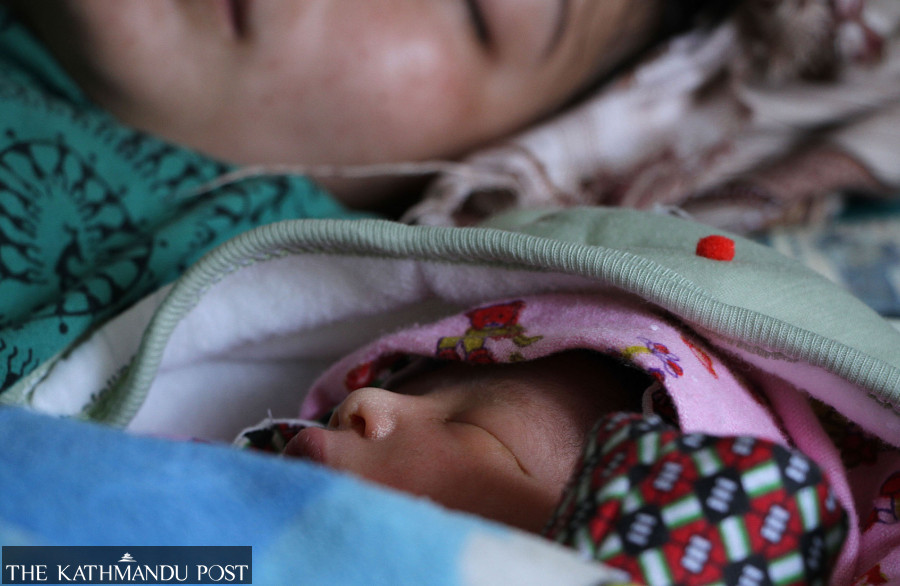Health
Expecting mothers who need Caesarean delivery are at risk in flood-ravaged Helambu
Government has a helicopter rescue programme to prevent maternal deaths, but health workers say the process is caught up in red tape.
Arjun Poudel
Seventeen-year-old Chandra Tamang (name changed), a resident of Helambu Rural Municipality-2 of Sindhupalchok, is expecting her first child in the first week of July.
Her due date is July 6 and she has been advised by the doctor at her local health facility to go to Kathmandu for delivery.
“Since she is underage, it will be riskier for her to give birth at the local health facility, which is ill equipped and lacks trained health workers,” Gyanendra Sigdel, health coordinator of Helambu Rural Municipality, told the Post over the phone. “It will be difficult to send her to Kathmandu immidiately in case she has to undergo a Caesarean section.”
Nepal has already missed the 2020 target of reducing maternal mortality to 125 per 100,000 live births from the current rate of 239 deaths per 100,000 live births.
The ongoing pandemic has made things worse, health experts say. Moreover, the recent flooding and landslide, which caused huge damage to roads and other infrastructure, pose additional risk to the lives of pregnant women and new mothers.
Helambu is one of the worst hit areas of Sindhupalchok from the recent flooding that killed dozens of people and displaced more than 1,000 others. At least seven people lost their lives and more than 400 others lost their homes in Helambu.
Road connectivity in Helambu has also been disrupted after floods swept away several motorable bridges.
Eighteen years old Rita Tamang, also from Helambu, is expecting her first baby next week. Like Chandra, she too has been advised by the doctor in her village to go to a hospital in Kathmandu for delivery.
Along with Chandra and Rita, there are six other expecting women, who are either in their teens or at the advanced maternal age(over 35 years old), whose due dates are within mid-July.
As teen pregnancy and pregnancy in advanced maternal age can be risky for both mother and the baby, health officials have advised these women to visit Kathmandu before the due date, so that they could give birth under professional care, in facilities that are well equipped.
But the problem is that all women cannot afford to go to Kathmandu immediately.
“Ambulance cannot come here because our village has been completely isolated after the recent flooding,” said Sigdel. “The ambulance operated by the local government is stuck at the office due to damaged roads.”
The government has been promoting institutional delivery to prevent such complications, with the government making delivery services free at state-run health facilities.
For pregnant women residing in remote villages, the government has been running a helicopter rescue programme in some local units and wards. The service is also available in Helambu.
Health workers, however, say that it will be too late if a pregnant woman whose condition is complicated has to wait for a helicopter rescue, a process which is caught up in red tape.
“We have to inform the chief of the district health office first, who in turn has to inform the chief district officer. The latter then will have to write a letter to officials at the Ministry of Women, Children and Social Welfare,” a paramedic serving at Helambu explained the process for helicopter rescue service. “Officials at the ministry then have to forward the letter to the Nepal Army and request for an airlift service.”
Maternal health experts say that the issue is not just limited to Helambu. It is the same for other remote places of the country.
“The name ‘President’s Women Uplift Programme’ under which the helicopter rescue programme is operated sounds fantastic, but it is too complicated in practice,” Dr Kiran Regmi, a former health secretary, told the Post. “It is not easy to get the helicopter rescue. Authorities should make the process simple to save the lives of mothers and their babies.”
The Ministry of Women, Children and Social Welfare, which runs the helicopter rescue programme, said that 87 women suffering maternity-related complications have been rescued since the start of the current fiscal year.
“We are not aware of the condition in Helambu. But if the chief district officer of the district where the programme is being implemented requests for the service, we will provide the service,”Goma Devi Dhakal, under secretary at the ministry, told the Post. “Some process has to be followed and recommendation of the chief district officer is the best for the service.”
Health workers serving in the remote villages, however, say that the government should get rid of the red tape and set up a mechanism at the centre to run emergency rescue service for pregnant women
“After all, the goal of the government programme is saving lives,” said Sigdel, the health coordinator of Helambu.
The National Demographic Health Survey 2016 shows that 21 babies in every 1,000 live births die within one month.
The survey also shows for every 100,000 births, 229 women die during or after childbirth. Nepal had previously reduced the maternal mortality rate from 539 in 1996 to 239 in 2016—for which the country received the Millennium Development Goal award.




 17.12°C Kathmandu
17.12°C Kathmandu














